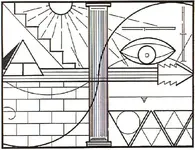Corporate Investigations
Sr. Member
- Joined
- Aug 23, 2013
- Messages
- 468
- Reaction score
- 1,438
- Golden Thread
- 0
- Primary Interest:
- All Treasure Hunting
Here's a picture of the Lue Map and my speculation about what it might mean.
View attachment 1302553
The pyramid with the T is Treasure Mountain. The shadow is on the west side of Treasure Mountain, so the sun is in the east. The five steps are five peaks east of Treasure Mountain. These peaks are Marble Mountain, Blanca Peak, Culebra Peak, Spanish Peaks and Black Mountain, nine miles east of Medano Pass. Black Mountain is a coded place name that I've posted about in the past. These peaks are also represented by the five lines going from Treasure Mountain to the east and represented by an arrow. If you go to google earth and mark these five peaks and then connect them with a line, you will have a shape similar to a pentagon. This is a huge surface layout of the constellation AURIGA. I've written about this layout in my KGC thread. If you split the word AURIGA into an AU and an RIGA, you have an AU which is the elemental symbol for GOLD. If you translate RIGA from Italian to English, you get LINE. GOLD LINE or GOLD LINES. The vertical column is the Mississippi River. The arrow shows that there will be five lines going east from Treasure Mountain. Three of these are important, the top and bottom bold marked lines and the middle line that extends to the point of the arrowhead. The eye with the circle over it represents Oak Island, O and EYE, O and I, Oak Island. The bold line of the arrowhead forms a V, this stands for Villamont, Virginia which represents the Beale legend. The three triangles at the bottom right of the Lue Map form a W which represents Wildcat Bluff, Arkansas, site of a KGC treasure legend. On google earth, start a line at each of these three sites and run the lines to Treasure Mountain. The line from Oak Island goes over Marble Mountain, the line from Villamont goes over Blanca Peak and the line from Wildcat Bluff goes over Culebra Peak. Run two more lines from Treasure Mountain over Black Mountain and Spanish Peaks and extend them east. I can't see where they go to a place of importance. If you look at these five lines, you will see that the three important lines have an unimportant line between them, just like the arrow on the Lue Map. You will also notice that the bottom line of unimportance is shown crossing the line of the Mississippi and the other unimportant line isn't. That's because the top line of unimportance is the Black Mountain line and Black Mountain is a coded name and must remain invisible. Another clue that shows the importance of the top, middle and bottom lines is the curved line that follows the arrow. It touches the bottom line, the top line and seems to end at the point of the arrowhead, same as the middle line.
Anyway, those are my observations, right or wrong.
Hello Mdog your observations right or wrong could be as correct and valid just as the many other 1 million and one versions of such a enigmatic puzzle? Sadly it may well be forever open to speculation? And that is problem of many treasure legends they taunt us of what if? While its fun to speculate it is in end we could spend our lives on such puzzles and still end up no further than where we began?
For me at least in regards to treasure legends the most promising ones is rather simple yet grounded in real people and events. I have one for the beautiful Colorado region, it was actually one of maybe one trio has already posted once posted somewhere ? if so I apologize for repeating it, if that's the case. While cynics may claim why give away a story with such promise? Well the trio really do not have the time to go further as they are involved in much more larger complex time consuming projects that for them that has more priority.It was an excellent story to research they gave me to follow up on a little as it shows promise. Yet perhaps you guys might know of it even though is a rather not so well know story these days. Yet it happened and of course like with all treasure legends there are gaps to be filled but the potential is there to continue.
Time gents is everyone enemy and I have a flight awaiting back to work in Brussels. Please remind me if you want to hear it on my return...
Amy
Amazon Forum Fav 👍
Last edited:




 If you would like me to go into more detail about the LUE map, and what I see, I'll be happy to. Also, you might want to read my thread in the KGC forum, Things for Further Research, and you will get some idea of where my thoughts are coming from as far as the LUE map goes.
If you would like me to go into more detail about the LUE map, and what I see, I'll be happy to. Also, you might want to read my thread in the KGC forum, Things for Further Research, and you will get some idea of where my thoughts are coming from as far as the LUE map goes.
